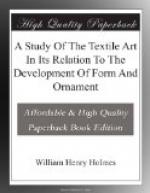In a primitive water vessel function gives a full outline, as capacity is a prime consideration; convenience of use calls for a narrow neck and a conical base; construction and materials unite to impose certain limitations to curves and their combinations, from which the artist cannot readily free himself. Models furnished by nature, as they are usually graceful, do not interfere with the preceding agencies, and all these forces united tend to give symmetry, grace, and the unity that belongs to simplicity. Taste which is in a formative state can but fall in with these tendencies of the art, and must be led by them, and led in a measure corresponding to their persistency and universality. If the textile art had been the only one known to man, ideas of the esthetic in shape would have been in a great measure formed through that art. Natural forms would have had little to do with it except through models furnished directly to and utilized by the art, for the ideas of primitive men concentrate about that upon which their hands work and upon which their thoughts from necessity dwell with steady attention from generation to generation.
RELATIONS OF FORM TO ORNAMENT.
It would seem that the esthetic tendencies of the mind, failing to find satisfactory expression in shape, seized upon the non-essential features of the art—markings of the surface and color of filaments—creating a new field in which to labor and expending their energy upon ornament.
Shape has some direct relations to ornament, and these relations may be classified as follows:
First, the contour of the vessel controls its ornament to a large extent, dictating the positions of design and setting its limits; figures are in stripes, zones, rays, circles, ovals, or rectangles—according, in no slight measure, to the character of the spaces afforded by details of contour. Secondly, it affects ornament through the reproduction and repetition of features of form, such as handles, for ornamental purposes. Thirdly, it is probable that shape influences embellishment through the peculiar bias given by it to the taste and judgment of men prior to or independent of the employment of ornament.
COLOR IN TEXTILE ART.
Color is one of the most constant factors in man’s environment, and it is so strongly and persistently forced upon his attention, so useful as a means of identification and distinction, that it necessarily receives a large share of consideration. It is probably one of the foremost objective agencies in the formation and development of the esthetic sense.
The natural colors of textile materials are enormously varied and form one of the chief attractions of the products of the art. The great interest taken in color—the great importance attached to it—is attested by the very general use of dyes, by means of which additional variety and brilliancy of effect are secured.




